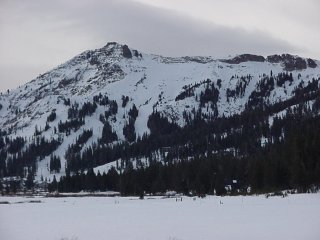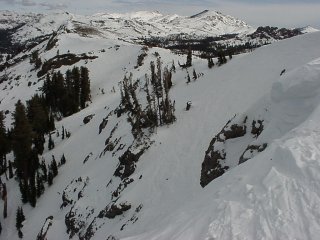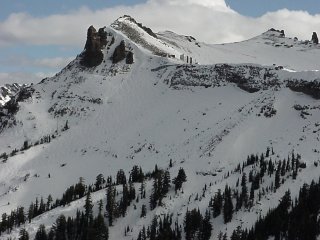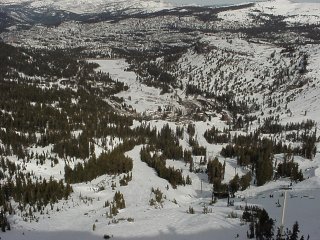Photos by Marc Guido
Kirkwood, CA – California is known for many things
– sunny beaches, drive-by shootings, high tech IPOs, thirty million souls clustered
between the San Andreas fault and the Pacific Ocean, and an roaring state economy
which proudly lays claim to being bigger than that of most Third World countries.
Kirkwood, literally and spiritually, might as well be situated on another planet.
Lying some thirty miles south of beautiful Lake Tahoe and the bustling twin
cities of South Lake Tahoe, California and Stateline, Nevada, or alternatively,
some 100 miles southeast of Sacramento, nobody stumbles into Kirkwood by accident.
They come to ski and board.
n
|
Kirkwood (photo Marc Guido) |
Located in one of the most remote and
least populated counties of the state and accessed via the oft-treacherous Carson
Pass on Highway 88, one can’t escape the sense upon arrival here that everyone
you meet on any given day is there for pretty much the same reasons. Deep,
deep snow. Sick terrain. A hardcore but “laid-back-local” attitude. That’s
Kirkwood in a nutshell. If you want varied nightlife, shopping and cappuccino
bars my friend, look elsewhere. If you want a fantastic ski experience, you’ve
arrived at Mecca.
Our family lives for skiing -so much
so that I suppose you could call us “hardcore family” skiers. Being typically
jaded from the thirty days or so we had spent on eastern hardpack by mid-winter
2000, we were on a mission to ski the west with a vengeance. Two days into our
scheduled ski week throughout the Tahoe area – where we would eventually rip
six resorts in six days – we found ourselves disembarking early from our modest
South Lake Tahoe motel. After a quick pit stop to load up on caffeine and carbs,
we headed south down Highway 88 for the 40 minute trek to Kirkwood.
Frankly, skiing Kirkwood had been foremost
in my plans since I first booked our Southwest Air flights out of Detroit to
Reno. However, as I glanced across the front seat at my partner, Briar – her
face swollen and barely recognizable after a previous day of hard skiing at
Heavenly sans sun screen – I could sense she had other thoughts on her mind.
Like maybe thoughts along the lines of “Is there a barf bag in the vehicle?”
The kids, Jacquelin, 14 and Jonathon, 10, were, on the other hand, still very
excited despite the tomato-like appearance and texture of their faces. Their
animation heightened as I advised them that the U.S. National Extreme Skiing
Competition was scheduled to take place at the resort that day. “Do you think
we’ll see Seth Morrison there today Dad?” implored Jonathon. He’s a real Seth
fan. I answered that I didn’t know, all the while secretly reckoning to myself
that the kid’s face would perfectly match Seth’s day-glo hair today.
Located in the stunningly gorgeous
alpine valley, Kirkwood came rather late onto the Tahoe scene. As late as 1970,
the area was frequented by little more than bears, deer and the odd holdover
prospector. All that changed when Bud Klein, acting upon U.S. Forest Service
personnel recommendations, organized Kirkwood Meadows Inc. with a view to developing
a new resort. With what today seems to be lightning speed, the group and the
state began to implement a master plan for the mountain.
As I’ve said, the resort was so remote
that, believe it or not, the group needed to construct its own electrical power
generating facility after the California Power Commission declined to pay to
run services into the valley. Work progressed quickly, and by 1972, the first
four lifts were up and running, together with the base lodge, some employee
housing, and rudimentary lodging facilities. Between 1972 and 1986, the last
of the completely new chairlifts was installed, although upgrades have continued
periodically until this day.
Kirkwood has one of the highest base
elevations in the Tahoe area, and it vies with Sugar Bowl at the north end for
the annual title for the highest snowfall in the region. In fact, for the last
few years running, Kirkwood has boasted the greatest rolling average of total
snowfall and base depth of any resort in the continental United States. While
1999-2000 was not a record year, Kirkwood’s snowfall totals would still be viewed
enviously by most other resorts.
Unfortunately, Kirkwood languished
relatively unnoticed for years as a result of its limited attractions beyond
its phenomenal skiing. There was no base village per se, no real nightlife,
and virtually no slope-side lodging save and except for some small condo complexes.
For better or worse, all that is about to change in the near future.
Now owned by Klein, with Charles E.
Cobb and Mountain Springs Resorts (which also has an interest in Durango Mountain
Resort) as significant investors, Kirkwood is poised to grow under an astute,
hands-on management team led by Tim Cohee, director of resort operations since
1993. The stated goal is that Kirkwood be poised to explode into the national
ski consciousness with a full blown base re-development project, as well as
significant on-mountain improvements. This would include slope-side lodging,
base lodge expansion, and the typical gamut of leisure-oriented ancillary business
development. Thankfully, there is little or nothing the resort feels it need
do to “improve” the actual ski experience.
True to legend, the depth of the snow
banks began to increase exponentially as we drove up Kirkwood’s long access
road and were funneled back to the public parking area. Kirkwood base is an
impressive and well designed facility at present, with lodging, rentals, ski
school and a few condos forming an attractive, compact complex. The buildings
are of an attractive, uniform style with plenty of room in the boot changing
facility and storage lockers. I particularly liked the electronic multiple-use
lockers which put an end to the usual practice of continually feeding in additional
change throughout the day. We quickly booted up and made ready to hit the
slopes.
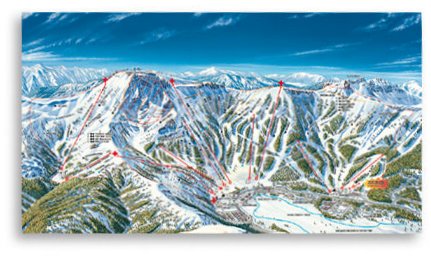 Kirkwood
Kirkwood
can be visualized as basically a long, east-west trending Y-shaped ridge line
dominated by jagged Thimble Peak at the point of intersection of the Y’s arms.
The main ski runs pour off the north face of the ridge. As well, additional
east and southeast facing runs are located in a huge secondary bowl area up
and in the internal crotch of the “Y”. Got it? Kirkwood literature boasts
of the resort having 2,000 feet of vertical drop, but the actual usable vertical
is about 1,800 feet on any given run. However, the natural layout of the resort
makes for some of sweetest, most sustained vertical to be found anywhere, with
most runs utilizing the full vertical and leaving little or no boring runouts
or traverses at the base of the mountain.
The runs also hold true to their designations.
In other words, the greens are green, the blues are true blue, and the skull
and crossbones trails (yes, they actually designate some as such here) do not
suffer fools gladly. Because Kirkwood is such a broad ridge of a mountain,
a bit of traversing from the top of most lifts is often necessary. However,
great lines can be accessed with little more than a minute or so of effort.
This layout does tend to lead one to yo-yo the same lift for a few runs before
eventually moving on to explore the terrain of other lift served areas of the
resort.
If Kirkwood possesses an irritating
flaw, it’s probably best described as “attitude.” Twice during the day – once
by a liftie and a second time by a ski patroller, I was ordered, rather brusquely,
“Get in the proper line buddy.” Perhaps it was the stress occasioned by the
Extreme Competition, but I don’t particularly care to be treated in this fashion
when I’m voluntarily spending my hard earned vacation coin at their resort.
Further, I did not hear anything in a similar vein while visiting any other
Tahoe resort that week.
As we traveled up the “Reut” (a short
lift named for Dick Reuter, one the original trail builders), I was struck by
the number of carving snowboards in use on the mountain. Some of these riders
were carving the deepest deep trenches I’ve ever seen. To our right, we looked
down into “The Drain,” an immense natural halfpipe, one of seven such areas
on the mountain. At the time of our visit, Kirkwood had no high speed lifts.
However, that is no longer the case with the opening of the resort’s first high
speed quad for 2000-2001, replacing Chair 6 to the ridge line. Other high
speed chairs are in the works.
After first working The Drain and some
other steep runs off the Norm’s Nose area, we took PR Director Tanya Pilkington’s
advice and traversed up and over to the east side to sample the Sunrise Bowl
area. Sunrise Bowl is a massive area of ungroomed snow, rated single black.
However, and somewhat of an anomaly on this mountain, it is easily managed by
a competent intermediate. I traversed over to the lip of The Wave, the name
given to the large area in the center of the bowl, as I contemplated how much
of a cornice I wanted to leap from. The condition of the snow was the stuff
of dreams. Deep, soft powder and chowder, grippy without being mushy.
|
You want steeps?! |
We skied several runs out of the bowl
area until the mid-morning sun began to soften the snow too much for our liking.
Traversing to skiers’ left off the top of the Sunrise Quad, we paused for a
minute under the northeast face of Thimble Peak to watch the latest in a seemingly
unending sequence of extreme skiers crash and burn, each one dropping like a
waxed rock down the jagged chutes of the Cirque. A truly imposing promontory,
Thimble Peak is only opened for this particular contest each year. We all felt
lucky to witness some of the best, most challenging skiing I’ve seen in quite
some time.
All too quickly, it was time to move
on and sample some of Kirkwood’s finest terrain. The Wagon Wheel Chair is clearly
marked with a skull and crossbones at both the top and bottom of the lift.
For the uninitiated – no, you don’t have to be a super-expert to ski the terrain
off this lift, but it helps. This is particularly so in slick or cruddy snow
conditions. However, provided you can handle typical single black diamond terrain,
you absolutely must ski this area of the resort. The Wagon Wheel Bowl area
is, not surprisingly, a steep wide bowl under and to skiers’ left of the lift.
Some of the steepest runs and biggest-air cornice entries are reached by traversing
out either to the left or right of the lift. All of the runs, more or less,
funnel down into one of the aforementioned natural halfpipes.
Both of the kids literally dove down
the slope, occasionally emitting sharp yelps of excitement to go along with
their regular face-plants. I followed on my trusty X-Screams, similarly exhilarated,
but did not face-plant. Wagon Wheel bowl is relatively shaded for much of the
day, and preserves its snow conditions very well. Quite frankly, I could have
skied lines off this lift all day, but eventually we needed to refuel our rapidly
tiring muscles.
For lunch, we retired upstairs to the
efficient and generously appointed lounge area. I’m not sure if I was especially
hungry that day, but the food, literally piled sky-high on the passing trays,
looked particularly inviting. During the week, I’d determined that one of the
area specialties was a gigantic bread bowl filled with various and sundry soups
or chili. Kirkwood earns a gold star for this menu item – in taste, volume,
and value for the money. As an aside, I’ve never experienced fountain water
at any ski resort (or for that matter, anywhere) which tasted so pure and refreshing.
Perhaps that pristine remoteness has its rewards.
After lunch, we quickly hit Lift 6,
the mountain’s other workhorse lift. Lift 6 (the Cornice chair) is a fixed
grip triple to the ridge line near the middle of the western-most sector of
the resort and accesses a huge chunk of terrain along the ridge—all of it rated
advanced or expert, and much of it requiring a leap into thin air off a rock
ledge or cornice. Seriously folks, I’m in pretty go shape for my age and don’t
scare at all easily. However, after traversing skiers’ left from Chair 6 to
near the lip of the Chamoix and Jim’s Run areas, it took little more than some
passive verbal discouragement from Briar for me to elect not to
follow the tracks upon which I was standing. Beyond the lip, and about 50 or
so feet of thin air below, lay the first turn! Muttering something about discretion
being required on Day Two of an expensive six day vacation, I vowed to do the
cornice leap next year.
|
The Wall
|
Despite Heavenly’s reputation as the
area magnet for Euros, I spoke to several Brits on the lifts that day. In particular,
one Irish couple was positively effusive in their praise of the mountain. “Best
mountain in the world. We’ve come back every year six years running,” was the
cheerful reply to my query.
Skiing hard until 4:00 p.m., we returned
to the lodge whereupon I retired upstairs to chat with Tanya. I inquired about
the recent decision by Cohee to leave the employ of the resort, and his quick
reconsideration of same shortly thereafter. “Kirkwood is a special place,” explained
Tanya. “Tim recognized that things are changing around here and that the future
expansion looks like an exciting time to be involved.”
Tanya went on to explain what draws
skiers to Kirkwood. “For skiers, it’s the snow and terrain. For families,
it’s the reasonable prices and secluded, quiet environment.” In that regard,
Kirkwood offers a plethora of ticket packages, including an extraordinarily
reasonable $10 daily child’s ticket. This season, Kirkwood offered an early
purchase, mid-week season pass for a similarly extraordinary $199.
Kirkwood is on the international radar
screen now. Judging from our wonderful experience that day last March, it
has earned that recognition the hard way. And everyone knows that when you
do something the hard way, you appreciate it all the more.

